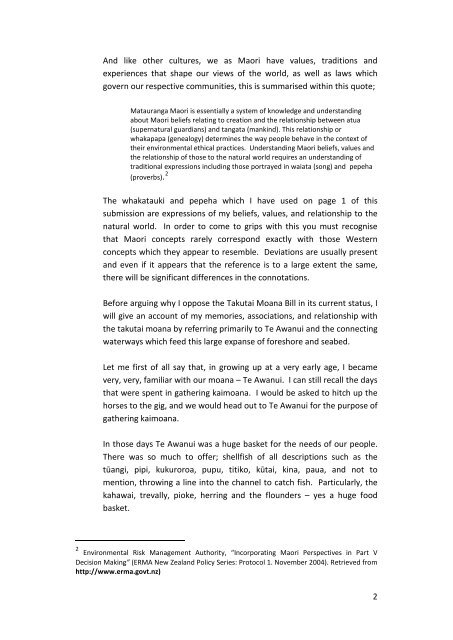(TAKUTAI MOANA) BILL E kau I te wai e, e kau I te wa
(TAKUTAI MOANA) BILL E kau I te wai e, e kau I te wa
(TAKUTAI MOANA) BILL E kau I te wai e, e kau I te wa
Create successful ePaper yourself
Turn your PDF publications into a flip-book with our unique Google optimized e-Paper software.
And like other cultures, we as Maori have values, traditions and<br />
experiences that shape our views of the world, as well as laws which<br />
govern our respective communities, this is summarised within this quo<strong>te</strong>;<br />
Matauranga Maori is essentially a sys<strong>te</strong>m of knowledge and understanding<br />
about Maori beliefs relating to creation and the relationship between atua<br />
(supernatural guardians) and tangata (mankind). This relationship or<br />
whakapapa (genealogy) de<strong>te</strong>rmines the <strong>wa</strong>y people behave in the con<strong>te</strong>xt of<br />
their environmental ethical practices. Understanding Maori beliefs, values and<br />
the relationship of those to the natural world requires an understanding of<br />
traditional expressions including those portrayed in <strong><strong>wa</strong>i</strong>ata (song) and pepeha<br />
(proverbs). 2<br />
The whakatauki and pepeha which I have used on page 1 of this<br />
submission are expressions of my beliefs, values, and relationship to the<br />
natural world. In order to come to grips with this you must recognise<br />
that Maori concepts rarely correspond exactly with those Wes<strong>te</strong>rn<br />
concepts which they appear to resemble. Deviations are usually present<br />
and even if it appears that the reference is to a large ex<strong>te</strong>nt the same,<br />
there will be significant differences in the connotations.<br />
Before arguing why I oppose the Takutai Moana Bill in its current status, I<br />
will give an account of my memories, associations, and relationship with<br />
the takutai moana by referring primarily to Te A<strong>wa</strong>nui and the connecting<br />
<strong>wa</strong><strong>te</strong>r<strong>wa</strong>ys which feed this large expanse of foreshore and seabed.<br />
Let me first of all say that, in growing up at a very early age, I became<br />
very, very, familiar with our moana – Te A<strong>wa</strong>nui. I can still recall the days<br />
that were spent in gathering kaimoana. I would be asked to hitch up the<br />
horses to the gig, and we would head out to Te A<strong>wa</strong>nui for the purpose of<br />
gathering kaimoana.<br />
In those days Te A<strong>wa</strong>nui <strong>wa</strong>s a huge basket for the needs of our people.<br />
There <strong>wa</strong>s so much to offer; shellfish of all descriptions such as the<br />
tūangi, pipi, kukuroroa, pupu, titiko, kūtai, kina, paua, and not to<br />
mention, throwing a line into the channel to catch fish. Particularly, the<br />
kaha<strong><strong>wa</strong>i</strong>, trevally, pioke, herring and the flounders – yes a huge food<br />
basket.<br />
2 Environmental Risk Management Authority, “Incorporating Maori Perspectives in Part V<br />
Decision Making” (ERMA New Zealand Policy Series: Protocol 1. November 2004). Retrieved from<br />
http://www.erma.govt.nz)<br />
2






![Full evidence text [PDF 8908k] - New Zealand Parliament](https://img.yumpu.com/14025494/1/184x260/full-evidence-text-pdf-8908k-new-zealand-parliament.jpg?quality=85)
![−3 JUN 2009 IRELEASED] - New Zealand Parliament](https://img.yumpu.com/12829724/1/185x260/3-jun-2009-ireleased-new-zealand-parliament.jpg?quality=85)
![Full paper text [PDF 3515k] - New Zealand Parliament](https://img.yumpu.com/11267192/1/184x260/full-paper-text-pdf-3515k-new-zealand-parliament.jpg?quality=85)


![Full evidence text [PDF 9k] - Parliament](https://img.yumpu.com/7938085/1/184x260/full-evidence-text-pdf-9k-parliament.jpg?quality=85)





